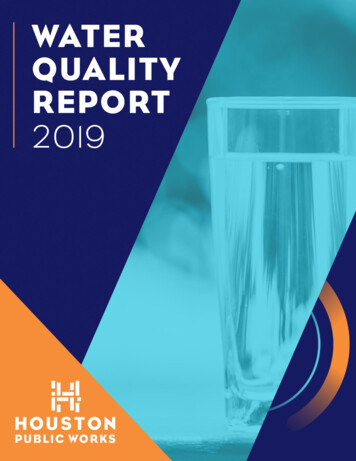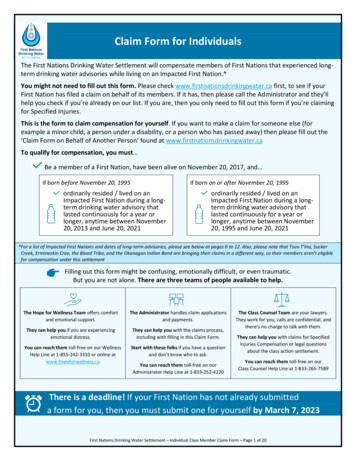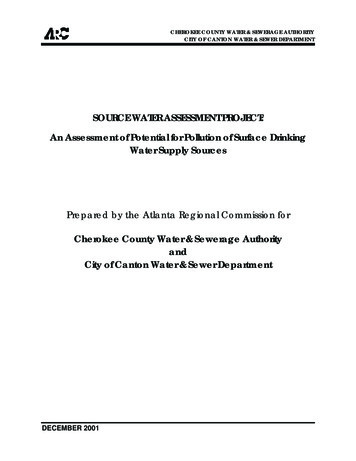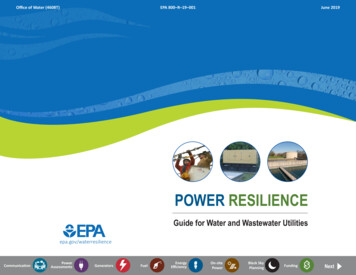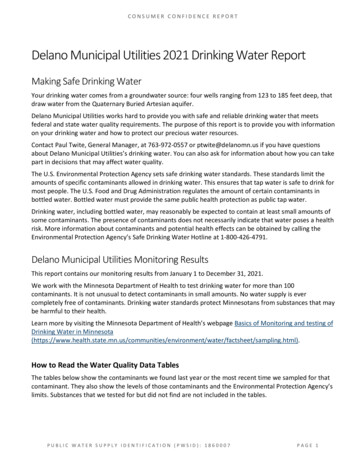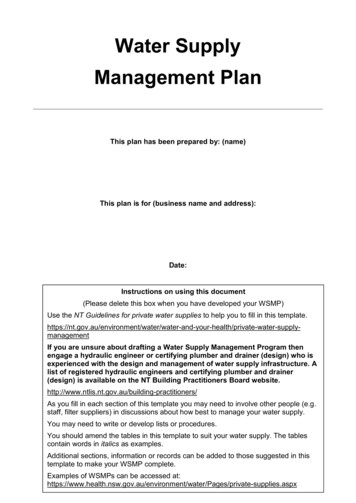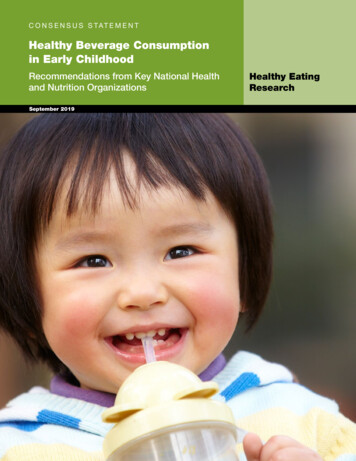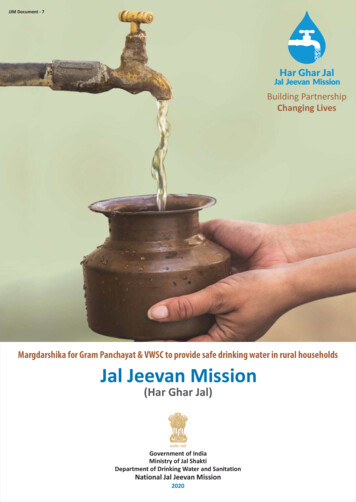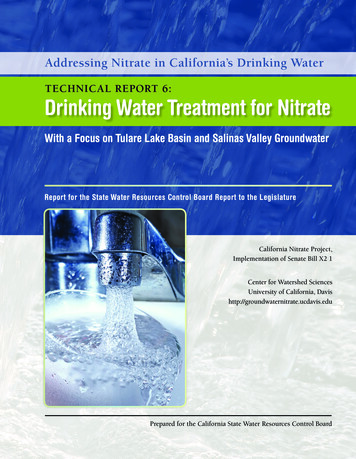
Transcription
Addressing Nitrate in California’s Drinking WaterTECHNICAL REPORT 6:Drinking Water Treatment for NitrateWith a Focus on Tulare Lake Basin and Salinas Valley GroundwaterReport for the State Water Resources Control Board Report to the LegislatureCalifornia Nitrate Project,Implementation of Senate Bill X2 1Center for Watershed SciencesUniversity of California, Davishttp://groundwaternitrate.ucdavis.eduPrepared for the California State Water Resources Control Board
Drinking Water Treatment for NitrateTechnical Report 6Addressing Nitrate in California’s Drinking WaterWith a Focus on Tulare Lake Basin and Salinas Valley GroundwaterReport for the State Water Resources Control Board Report to the LegislaturePrepared by:Vivian B. Jensen and Jeannie L. Darby1 of UC DavisChad Seidel and Craig Gorman of Jacobs Engineering Group, Inc.2Center for Watershed SciencesUniversity of California, DavisCalifornia Nitrate Project, Implementation of Senate Bill X2 1Prepared for:California State Water Resources Control BoardJuly 20121Corresponding author: jdarby@ucdavis.eduThe first portion of this document (through the end of Section 3) was developed concurrently for the American Water WorksAssociation (AWWA) as the report titled An Assessment of the State of Nitrate Treatment Alternatives (2011) throughcollaboration with Chad Seidel, Ph.D., P.E. and Craig Gorman, M.S., P.E. of Jacobs Engineering Group, Inc.2
Suggested Citation:Jensen, V.B., Darby, J.L., Seidel, C. & Gorman, C. (2012) Drinking Water Treatment for Nitrate. Technical Report 6in: Addressing Nitrate in California’s Drinking Water with a Focus on Tulare Lake Basin and Salinas ValleyGroundwater. Report for the State Water Resources Control Board Report to the Legislature. Center for WatershedSciences, University of California, Davis.An electronic copy of this Final Report is available from the following ight 2012 The Regents of the University of CaliforniaAll rights ReservedThe University of California prohibits discrimination or harassment of any person on the basis of race, color,national origin, religion, sex, gender identity, pregnancy (including childbirth, and medical conditions related topregnancy or childbirth), physical or mental disability, medical condition (cancer-related or genetic characteristics),ancestry, marital status, age, sexual orientation, citizenship, or service in the uniformed services (as defined by theUniformed Services Employment and Reemployment Rights Act of 1994: service in the uniformed services includesmembership, application for membership, performance of service, application for service, or obligation for servicein the uniformed services) in any of its programs or activities. University policy also prohibits reprisal or retaliationagainst any person in any of its programs or activities for making a complaint of discrimination or sexualharassment or for using or participating in the investigation or resolution process of any such complaint. Universitypolicy is intended to be consistent with the provisions of applicable State and Federal laws.Disclaimer: This document is intended as a guide of nitrate treatment technologies and should be used as aninformational tool only. The contents of this document are solely the responsibility of the authors and do notnecessarily represent the official views of supporting agencies. The selection and design of the most appropriatenitrate treatment alternative for a particular water system depend on a variety of factors and require the expertiseof experienced professional engineers. Discussion of proprietary technologies is intended to provide informationabout treatment alternatives and does not imply endorsement.For further inquiries, please contactThomas Harter, Ph.D.ThHarter@ucdavis.edu125 Veihmeyer HallUniversity of CaliforniaDavis, CA 95616-8628Phone: 530-752-2709
AcknowledgmentsThis document is largely based on the report titled An Assessment of the State of Nitrate TreatmentAlternatives (2011) prepared for the American Water Works Association (AWWA) through collaborationwith Chad Seidel, Ph.D., P.E. and Craig Gorman, M.S., P.E. of Jacobs Engineering Group, Inc.3Special thanks to the members of the AWWA Inorganic Contaminants Research and Inorganic WaterQuality Project Subcommittee:NameAffiliationMichelle De Haan, ChairWater Works EngineersJennifer Baldwin, ChairCH2M HILLJess BrownCarollo EngineersSusan BrownsteinCalifornia Department of Public HealthDennis CliffordUniversity of HoustonElise HarringtonAWWATarrah HenrieCalifornia Water Service CompanyFrance LemieuxHealth CanadaJerry LowryLowry Systems, Inc.Support for this research was provided from the following sources: American Water Works Association Technical & Education Council California Department of Public Health Safe Drinking Water Revolving Fund Contract No. 0655254 California State Water Resources Control Board, Contract No. 09-122-2503The first portion of this document (through the end of Section 3) was developed concurrently for the American Water WorksAssociation (AWWA) as the report titled An Assessment of the State of Nitrate Treatment Alternatives (2011) throughcollaboration with Chad Seidel, Ph.D., P.E. and Craig Gorman, M.S., P.E. of Jacobs Engineering Group, Inc.Technical Report 6: Drinking Water Treatment for Nitrate
The authors would like to thank the following for their contributions to the ceUniversity of California, BerkeleySelf-Help EnterprisesUCD – Center for Watershed SciencesCDPH Division of Drinking Water and Environmental ManagementUCD – Information Center for the EnvironmentCDPH Division of Drinking Water and Environmental ManagementCDPH – Southern California Drinking Water Field Operations BranchCommunity Water CenterFresno County Environmental HealthUCD – Center for Watershed SciencesTulare County Department of Environmental Health – Water ProgramUCD – Center for Watershed SciencesAegis Groundwater Consulting, LLCKern County Environmental HealthUCD – Center for Watershed SciencesCDPH – Fresno District EngineerCSU FresnoUCD – Center for Watershed SciencesPacific InstituteWashington State Department of Health EngineerFresno CountyUCD – Information Center for the EnvironmentMonterey County Health Department – Drinking Water ProtectionServicesUCD – Graduate Student ResearcherCDPH – Division of Drinking Water and Environmental ManagementUCD – Undergraduate Student AssistantAdditionally, the authors would like to thank the drinking water utilities that participated in the surveyand the treatment technology vendors for their contributions to the project.Technical Report 6: Drinking Water Treatment for Nitrate
ContentsTables . vFigures . viiAcronyms and Abbreviations . ixUnit Conversions . xiSummary . 1Objective . 1Background . 1Approach . 2Findings . 5Non-Treatment Options . 5Treatment Options . 5Conclusions . 91 Introduction . 121.1 Management Options for Nitrate in Potable Water . 122 Non-Treatment Options for Nitrate Contaminated Potable Water . 142.1 Well Abandonment, Inactivation, and Destruction . 142.2 Wellhead Protection and Land Use Management . 142.3 Development of Alternative Sources and Source Modification . 142.4 Blending . 163 Treatment Options for Nitrate Contaminated Potable Water . 183.1 Ion Exchange (IX) . 213.1.1 Conventional Ion Exchange . 213.1.2 Ion Exchange - Design Considerations . 233.1.3 Ion Exchange - Cost Considerations . 28Technical Report 6: Drinking Water Treatment for Nitratei
3.1.4 Ion Exchange - Selected Research. 293.1.5 Ion Exchange - Summary of Advantages and Disadvantages . 293.1.6 Modifications to Conventional Ion Exchange . 293.1.7 Ion Exchange - Case Studies . 353.2 Reverse Osmosis (RO) . 483.2.1 Reverse Osmosis - Design Considerations . 483.2.2 Reverse Osmosis - Cost Considerations . 533.2.3 Reverse Osmosis - Selected Research . 543.2.4 Reverse Osmosis - Summary of Advantages and Disadvantages. 543.2.5 Reverse Osmosis - Improvements and Modifications . 553.2.6 Reverse Osmosis - Case Studies . 573.3 Electrodialysis (ED/EDR/SED) . 733.3.1 Electrodialysis - Design Considerations . 753.3.2 Electrodialysis - Cost Considerations . 773.3.3 Electrodialysis - Selected Research . 783.3.4 Electrodialysis - Summary of Advantages and Disadvantages . 783.3.5 Modifications to Electrodialysis . 793.3.6 Electrodialysis - Case Studies . 803.4 Biological Denitrification (BD) . 883.4.1 Biological Denitrification - Design Considerations . 903.4.2 Biological Denitrification - Cost Considerations. 953.4.3 Biological Denitrification - Selected Research . 963.4.4 Biological Denitrification - Summary of Advantages and Disadvantages . 963.4.5 Biological Denitrification - Case Studies. 973.5 Chemical Denitrification (CD). 106Technical Report 6: Drinking Water Treatment for Nitrateii
3.5.1 Zero Valent Iron (ZVI) . 1063.5.2 Catalytic Denitrification . 1083.5.3 Chemical Denitrification - Design Considerations. 1083.5.4 Chemical Denitrification - Emerging Technologies . 1103.5.5 Chemical Denitrification - Cost Considerations . 1133.5.6 Chemical Denitrification - Selected Research . 1143.5.7 Chemical Denitrification - Summary of Advantages and Disadvantages . 1143.6 Brine Treatment Alternatives and Hybrid Treatment Systems. 1143.6.1 Electrochemical Destruction of Nitrate in Waste Brine . 1153.6.2 Catalytic Treatment of Waste Brine. 1163.7 Residential Treatment (Point-of-Use, Point-of-Entry) . 1174 Tulare Lake Basin and Salinas Valley - Water Quality Analysis . 1204.1 Water Quality - Treatment Interference. 1214.2 Water Quality - Co-contaminants . 1214.3 Water Quality and Treatment Selection . 1285 Addressing Nitrate Impacted Potable Water Sources in California . 1305.1 Well Abandonment, Destruction and Inactivation . 1305.2 Survey of Blending and Treating Systems . 1336 Treatment Cost Analysis . 1396.1 Costs by Treatment Type . 1416.2 Costs by System Size . 1446.3 Costs by Water Quality Parameters . 1476.4 Disposal Costs . 1497 Guidance for Addressing Nitrate Impacted Drinking Water . 1527.1 Checklist for the Selection of Mitigation Strategy . 152Technical Report 6: Drinking Water Treatment for Nitrateiii
7.2 Decision Trees . 1538 Summary and Conclusions . 1559 Literature Cited . 15710 Appendix . 17510.1 Tables of Selected Research . 175Technical Report 6: Drinking Water Treatment for Nitrateiv
TablesTable S.1. Utilities included in the case studies. . 4Table S.2. Potable water treatment options for nitrate management . 6Table S.3. Comparison of major treatment types. . 11Table 1. Utilities included in the case studies. . 19Table 2. Potable water treatment options for nitrate management. 20Table 3. Selection of full-scale ion exchange installations for nitrate removal. . 21Table 4. Summary of design considerations for conventional IX. . 24Table 5. Selected published costs of ion exchange systems for nitrate removal. . 29Table 6. Summary of design considerations for reverse osmosis. . 49Table 7. Selected costs of reverse osmosis systems for nitrate removal. . 54Table 8. Summary of design considerations for electrodialysis/electrodialysis reversal. . 75Table 9. Sample EDR O&M costs. . 78Table 10. Full-scale biological denitrification systems for potable water treatment. . 89Table 11. Summary of design considerations for biological denitrification for nitrate removal. . 90Table 12. Membrane biological reactor configurations. 94Table 13. Cost information for biological denitrification of potable water. . 96Table 14. Summary of design considerations for chemical denitrification. 109Table 15. Selected research on brine treatment alternatives and hybrid systems . 115Table 16. Costs of POU treatment for nitrate removal. . 119Table 17. Summary of water quality data of high nitrate wells in Tulare Lake Basin and Salinas Valley.120Table 18. Comparison of major treatment types. . 129Table 19. Influence of nitrate concentration on treatment selection. . 129Table 20. Incidence of abandonment, destruction, and inactivation of nitrate impacted wells. 131Table 21. Population and nitrate levels of systems in the study area treating or blending for nitrate. 137Technical Report 6: Drinking Water Treatment for Nitratev
Table 22. Nitrate level, well depth and well capacity for a Tulare County blending system. . 138Table 23. Cost estimation using U.S. EPA cost curves of IX for arsenic removal. . 140Table 24. Summary of anion exchange and reverse osmosis cost information by system size. . 146Table 25. An exercise in the estimation of treatment costs based on nitrate levels. . 148Table 26. Brine disposal costs. . 150Table A.1. Selected research on the use of ion exchange for nitrate removal. . 175Table A.2. Selected research on the use of reverse osmosis for nitrate removal. . 176Table A.3. Selected research on the use of electrodialysis for nitrate removal. . 177Table A.4. Selected research on the use of biological denitrification for nitrate removal. . 178Table A.5. Selected research on the use of chemical denitrification for nitrate removal. . 181Table A.6. Advantages and disadvantages of the five major treatment options for nitrate removal. . 182Technical Report 6: Drinking Water Treatment for Nitratevi
FiguresFigure S.1. Summary of nitrate management options. . 2Figure 1. Selective well screening using a packer/plug. 16Figure 2. Conventional ion exchange schematic. 22Figure 3. Process flow diagram for counter current MIEX process. . 30Figure 4. Vessel rotation in Calgon Carbon countercurrent ISEP system. . 32Figure 5. Example of flow through the ISEP system. . 32Figure 6. Example of an Envirogen multiple bed proprietary anion exchange system. . 33Figure 7. Process schematic of weak base ion exchange for nitrate ("WIN" process). . 35Figure 8. Reverse osmosis schematic. 48Figure 9. Flow chart of the HERO process. . 56Figure 10. Electrodialysis reversal schematic. . 73Figure 11. Illustration of electrodialysis membrane stack. . 74Figure 12. Biological denitrification schematic. . 88Figure 13. FBR configuration. . 98Figure 14. FBR treatment system schematic. . 100Figure 15. Surface chemistry of ZVI particles . 107Figure 16. Process schematic for denitrification using SMI-III . . 111Figure 17. Schematic of the brine treatment system developed by Ionex SG Limited. . 116Figure 18. Schematic of an ion exchange system with brine regeneration coupled with catalytictreatment of brine for reuse. . 116Figure 19. Raw water nitrate levels exceeding the MCL . 122Figure 20. Raw water high nitrate wells with high arsenic levels. . 123Figure 21. Raw water high nitrate wells with high perchlorate levels. 124Figure 22. Raw water high nitrate wells with pesticides detected. . 125Technical Report 6: Drinking Water Treatment for Nitratevii
Figure 23. Salinas Valley [As] versus total well depth (deepest water) and [NO3-] versus depth to top ofscreen (shallowest water). . 127Figure 24. Tulare Lake Basin [As] versus total well depth (deepest water) and [NO3-] versus depth to topof screen (shallowest water). . 127Figure 25. Tulare Lake Basin: Incidence of nitrate and arsenic MCL exceedance with well depth. . 128Figure 26. Location of nitrate impacted abandoned, destroyed, and inactivated wells. . 132Figure 27. Digital survey distributed to drinking water systems treating and/or blending to address highnitrate levels. . 134Figure 28. California drinking water systems treating and/or blending for nitrate. 135Figure 29. Drinking water systems treating or blending for nitrate in the Tulare Lake Basin and SalinasValley. . 136Figure 30. Wells of a blending system in Tulare County. . 138Figure 31. Average cost comparison of nitrate treatment technologies. . 142Figure 32. Costs of anion exchange for nitrate treatment. . 143Figure 33. Costs of reverse osmosis for nitrate treatment. . 143Figure 34. Costs of biological denitrification in drinking water treatment. . 144Figure 35. Cost curve of IX (blue) and RO (red) for nitrate removal. . 145Figure 36. Decision Tree 1 - Options to address nitrate impacted drinking water sources . 153Figure 37. Decision Tree 2 - Anion exchange. . 154Technical Report 6: Drinking Water Treatment for Nitrateviii
Acronyms and FBRFXBGACGHGGPMGWUDIHERO HLRISEP IXLSIMBfRMBRMCLMGDMIEX NDMAO&MPICMEPOEPOUPRBROSBA IXSBRAcre FeetAcre Feet per YearAmerican Water Works AssociationBest Management PracticeBiological DenitrificationBed VolumeChemical DenitrificationClean-In-PlaceDisinfection ByproductDetection LimitDissolved OxygenEmpty Bed Contact TimeElectrodialysisElectrodialysis ReversalFluidized Bed ReactorFixed Bed ReactorGranular Activated CarbonGreenhouse GasGallons per MinuteGroundwater Under Direct Influence (of Surface Water)High Efficiency Reverse OsmosisHydraulic Loading RateIon Exchange Separation SystemIon ExchangeLangelier Saturation IndexMembrane Biofilm ReactorMembrane BioreactorMaximum Contaminant LevelMillion Gallons per DayMagnetic Ion ExchangeN-nitrosodimethylamineOperations and MaintenancePermits Inspection Compliance Monitoring and EnforcementPoint-of-EntryPoint-of-UsePermeable Reactive BarrierReverse OsmosisStrong Base Anion ExchangeSequencing Batch ReactorTechnical Report 6: Drinking Water Treatment for Nitrateix
SDISDWASEDSMITDSTSSULPROUSBRU.S. EPAVSEPWACWBA IXWQMZVISilt Density IndexSafe Drinking Water ActSelective ElectrodialysisSulfur Modified IronTotal Dissolved SolidsTotal Suspended SolidsUltra-Low Pressure Reverse OsmosisUp-flow Sludge Blanket ReactorUnited States Environmental Protection AgencyVibratory Shear Enhanced ProcessWeak Acid Cation ExchangeWeak Base Anion ExchangeWater Quality MonitoringZero Valent IronTechnical Report 6: Drinking Water Treatment for Nitratex
Unit ConversionsMetric to USUS to MetricMassMass1 gram (g)0.04 ounces (oz)1 ounce28.35 grams1 kilogram (kg)2.2 pounds (lb)1 pound0.45 kilograms1 megagram (Mg) (1 tonne)1.1 short tons1 short ton (2000 lb)0.91 meg
Technical Report 6: Drinking Water Treatment for Nitrate Acknowledgments This document is largely based on the report titled An Assessment of the State of Nitrate Treatment Alternatives (2011) prepared for the American Water Works Association (AWWA) through collaboration with Chad Seidel, Ph.D., P.E. and Craig Gorman, M.S., P.E. of Jacobs Engineering Group, Inc.3
